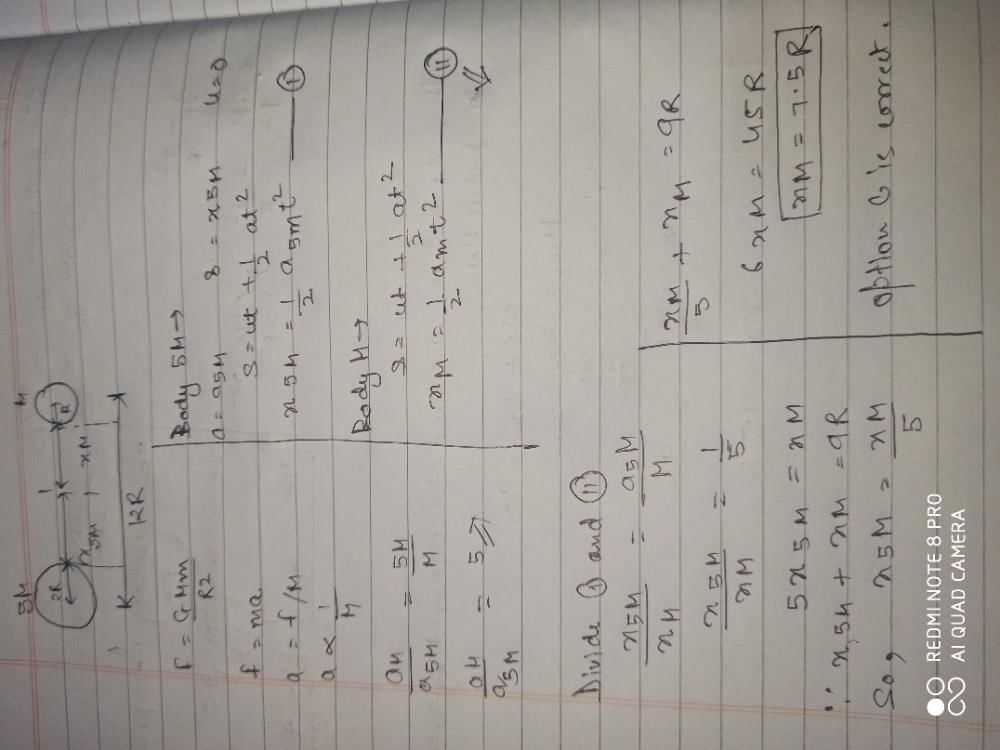Class 11 Exam > Class 11 Questions > Two spherical bodies of mass M and 5M and rad...
Start Learning for Free
Two spherical bodies of mass M and 5M and radii R and 2R respectively are released in free space with initial separation between their centres equal to 12R. If they attract each other due to gravitational force only. then the distance covered by the smaller body just before collision is [AIEEE 2003]
- a)2.5 R
- b)4.5 R
- c)7.5 R
- d)1.5 R
Correct answer is option 'C'. Can you explain this answer?
Verified Answer
Two spherical bodies of mass M and 5M and radii R and 2R respectively ...
View all questions of this test
Most Upvoted Answer
Two spherical bodies of mass M and 5M and radii R and 2R respectively ...
Given:
- Two spherical bodies of mass M and 5M and radii R and 2R respectively.
- Initial separation between their centres equal to 12R.
- They attract each other due to gravitational force only.
To find:
- The distance covered by the smaller body just before collision.
Solution:
1. Let the smaller body of mass M be A and the larger body of mass 5M be B.
2. At any instant, let the distance between their centres be d.
3. By gravitational force, A experiences a force of F = GM(5M)/(d^2), where G is the gravitational constant.
4. By Newton's second law of motion, the acceleration of A is a = F/M = GM(5M)/(Md^2) = G(5M)/(d^2).
5. Let v be the velocity of A at any instant. Then, by kinematics, v^2 = 2ad = 2G(5M)/(d^2) * 12R.
6. Let d1 be the distance covered by A just before collision. Then, at that instant, d = 3R (since the sum of their radii is 3R).
7. Substituting d = 3R in the above equation, we get v^2 = 2G(5M)/(9R^2) * 12R = 80GM/R.
8. At collision, the relative velocity of A and B is v1 = 2v = 2sqrt(80GM/R).
9. Let t be the time taken by A to cover the distance d1. Then, d1 = v1t.
10. To find t, we need to find the distance travelled by B in the same time.
11. The acceleration of B is b = G(5M)/(4R)^2 = 5G(5M)/(16R^2).
12. Let u be the initial velocity of B. Then, by kinematics, d = ut + (1/2)bt^2.
13. At t = 0, d = 12R and u = 0. Substituting, we get 12R = (1/2)(5G(5M)/(16R^2))t^2, or t^2 = 384GM/(5R^3).
14. Substituting t^2 in d = ut + (1/2)bt^2, we get d = (1/2)bt^2 = 15GM/R.
15. Therefore, the distance covered by A just before collision is d1 = v1t = 2sqrt(80GM/R) * sqrt(384GM/(5R^3)) = 48R/5 = 9.6R.
Therefore, the correct option is (c) 7.5R.
- Two spherical bodies of mass M and 5M and radii R and 2R respectively.
- Initial separation between their centres equal to 12R.
- They attract each other due to gravitational force only.
To find:
- The distance covered by the smaller body just before collision.
Solution:
1. Let the smaller body of mass M be A and the larger body of mass 5M be B.
2. At any instant, let the distance between their centres be d.
3. By gravitational force, A experiences a force of F = GM(5M)/(d^2), where G is the gravitational constant.
4. By Newton's second law of motion, the acceleration of A is a = F/M = GM(5M)/(Md^2) = G(5M)/(d^2).
5. Let v be the velocity of A at any instant. Then, by kinematics, v^2 = 2ad = 2G(5M)/(d^2) * 12R.
6. Let d1 be the distance covered by A just before collision. Then, at that instant, d = 3R (since the sum of their radii is 3R).
7. Substituting d = 3R in the above equation, we get v^2 = 2G(5M)/(9R^2) * 12R = 80GM/R.
8. At collision, the relative velocity of A and B is v1 = 2v = 2sqrt(80GM/R).
9. Let t be the time taken by A to cover the distance d1. Then, d1 = v1t.
10. To find t, we need to find the distance travelled by B in the same time.
11. The acceleration of B is b = G(5M)/(4R)^2 = 5G(5M)/(16R^2).
12. Let u be the initial velocity of B. Then, by kinematics, d = ut + (1/2)bt^2.
13. At t = 0, d = 12R and u = 0. Substituting, we get 12R = (1/2)(5G(5M)/(16R^2))t^2, or t^2 = 384GM/(5R^3).
14. Substituting t^2 in d = ut + (1/2)bt^2, we get d = (1/2)bt^2 = 15GM/R.
15. Therefore, the distance covered by A just before collision is d1 = v1t = 2sqrt(80GM/R) * sqrt(384GM/(5R^3)) = 48R/5 = 9.6R.
Therefore, the correct option is (c) 7.5R.
Free Test
FREE
| Start Free Test |
Community Answer
Two spherical bodies of mass M and 5M and radii R and 2R respectively ...


|
Explore Courses for Class 11 exam
|

|
Question Description
Two spherical bodies of mass M and 5M and radii R and 2R respectively are released in free space with initial separation between their centres equal to 12R. If they attract each other due to gravitational force only. then the distance covered by the smaller body just before collision is [AIEEE 2003]a)2.5 Rb)4.5 Rc)7.5 Rd)1.5 RCorrect answer is option 'C'. Can you explain this answer? for Class 11 2025 is part of Class 11 preparation. The Question and answers have been prepared according to the Class 11 exam syllabus. Information about Two spherical bodies of mass M and 5M and radii R and 2R respectively are released in free space with initial separation between their centres equal to 12R. If they attract each other due to gravitational force only. then the distance covered by the smaller body just before collision is [AIEEE 2003]a)2.5 Rb)4.5 Rc)7.5 Rd)1.5 RCorrect answer is option 'C'. Can you explain this answer? covers all topics & solutions for Class 11 2025 Exam. Find important definitions, questions, meanings, examples, exercises and tests below for Two spherical bodies of mass M and 5M and radii R and 2R respectively are released in free space with initial separation between their centres equal to 12R. If they attract each other due to gravitational force only. then the distance covered by the smaller body just before collision is [AIEEE 2003]a)2.5 Rb)4.5 Rc)7.5 Rd)1.5 RCorrect answer is option 'C'. Can you explain this answer?.
Two spherical bodies of mass M and 5M and radii R and 2R respectively are released in free space with initial separation between their centres equal to 12R. If they attract each other due to gravitational force only. then the distance covered by the smaller body just before collision is [AIEEE 2003]a)2.5 Rb)4.5 Rc)7.5 Rd)1.5 RCorrect answer is option 'C'. Can you explain this answer? for Class 11 2025 is part of Class 11 preparation. The Question and answers have been prepared according to the Class 11 exam syllabus. Information about Two spherical bodies of mass M and 5M and radii R and 2R respectively are released in free space with initial separation between their centres equal to 12R. If they attract each other due to gravitational force only. then the distance covered by the smaller body just before collision is [AIEEE 2003]a)2.5 Rb)4.5 Rc)7.5 Rd)1.5 RCorrect answer is option 'C'. Can you explain this answer? covers all topics & solutions for Class 11 2025 Exam. Find important definitions, questions, meanings, examples, exercises and tests below for Two spherical bodies of mass M and 5M and radii R and 2R respectively are released in free space with initial separation between their centres equal to 12R. If they attract each other due to gravitational force only. then the distance covered by the smaller body just before collision is [AIEEE 2003]a)2.5 Rb)4.5 Rc)7.5 Rd)1.5 RCorrect answer is option 'C'. Can you explain this answer?.
Solutions for Two spherical bodies of mass M and 5M and radii R and 2R respectively are released in free space with initial separation between their centres equal to 12R. If they attract each other due to gravitational force only. then the distance covered by the smaller body just before collision is [AIEEE 2003]a)2.5 Rb)4.5 Rc)7.5 Rd)1.5 RCorrect answer is option 'C'. Can you explain this answer? in English & in Hindi are available as part of our courses for Class 11.
Download more important topics, notes, lectures and mock test series for Class 11 Exam by signing up for free.
Here you can find the meaning of Two spherical bodies of mass M and 5M and radii R and 2R respectively are released in free space with initial separation between their centres equal to 12R. If they attract each other due to gravitational force only. then the distance covered by the smaller body just before collision is [AIEEE 2003]a)2.5 Rb)4.5 Rc)7.5 Rd)1.5 RCorrect answer is option 'C'. Can you explain this answer? defined & explained in the simplest way possible. Besides giving the explanation of
Two spherical bodies of mass M and 5M and radii R and 2R respectively are released in free space with initial separation between their centres equal to 12R. If they attract each other due to gravitational force only. then the distance covered by the smaller body just before collision is [AIEEE 2003]a)2.5 Rb)4.5 Rc)7.5 Rd)1.5 RCorrect answer is option 'C'. Can you explain this answer?, a detailed solution for Two spherical bodies of mass M and 5M and radii R and 2R respectively are released in free space with initial separation between their centres equal to 12R. If they attract each other due to gravitational force only. then the distance covered by the smaller body just before collision is [AIEEE 2003]a)2.5 Rb)4.5 Rc)7.5 Rd)1.5 RCorrect answer is option 'C'. Can you explain this answer? has been provided alongside types of Two spherical bodies of mass M and 5M and radii R and 2R respectively are released in free space with initial separation between their centres equal to 12R. If they attract each other due to gravitational force only. then the distance covered by the smaller body just before collision is [AIEEE 2003]a)2.5 Rb)4.5 Rc)7.5 Rd)1.5 RCorrect answer is option 'C'. Can you explain this answer? theory, EduRev gives you an
ample number of questions to practice Two spherical bodies of mass M and 5M and radii R and 2R respectively are released in free space with initial separation between their centres equal to 12R. If they attract each other due to gravitational force only. then the distance covered by the smaller body just before collision is [AIEEE 2003]a)2.5 Rb)4.5 Rc)7.5 Rd)1.5 RCorrect answer is option 'C'. Can you explain this answer? tests, examples and also practice Class 11 tests.

|
Explore Courses for Class 11 exam
|

|
Signup for Free!
Signup to see your scores go up within 7 days! Learn & Practice with 1000+ FREE Notes, Videos & Tests.
























